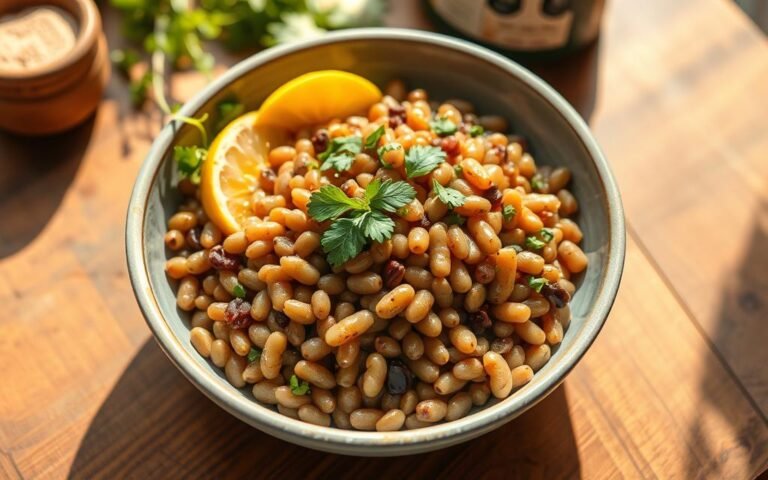Managing blood sugar levels is crucial for diabetics, and incorporating the right foods into their diet can make a significant difference. Lentils, rich in protein, dietary fiber, and essential vitamins and minerals, are a nutritious and versatile food that can be beneficial for diabetics.
Lentils have been recognized for their potential role in a diabetic-friendly diet, helping to manage glucose levels effectively. By understanding the nutritional benefits of lentils, diabetics can make informed choices about their diet.
Key Takeaways
- Lentils are rich in protein and dietary fiber, making them beneficial for diabetics.
- Incorporating lentils into the diet can help manage blood sugar levels.
- Lentils are a versatile food that can be prepared in various diabetic-friendly ways.
- A diet rich in lentils can contribute to overall glucose management.
- Understanding the nutritional benefits of lentils is key to making informed dietary choices.
The Diabetes Epidemic in Australia
The diabetes epidemic in Australia is a growing concern, affecting a substantial portion of the population. As the prevalence of diabetes continues to rise, it’s essential to understand the current statistics and trends, as well as the role of diet in managing Type 2 Diabetes.
Current Statistics and Trends
Australia is experiencing a significant increase in diabetes cases, with over 1.2 million Australians living with the condition. According to recent statistics, the prevalence of diabetes in Australia is among the highest in the developed world. The trend indicates a steady rise, emphasizing the need for effective diabetes management strategies.
| Year | Diabetes Prevalence | Projected Increase |
|---|---|---|
| 2020 | 1.2 million | 20% |
| 2030 | 1.5 million | 30% |
The Role of Diet in Managing Type 2 Diabetes
Diet plays a crucial role in managing Type 2 Diabetes. Diabetic-friendly foods such as lentils can significantly impact blood sugar control. Lentils are rich in fiber and protein, making them an ideal food for managing lentils blood sugar levels. Incorporating lentils into one’s diet can be a beneficial strategy for diabetes management.
By understanding the impact of diet on diabetes and incorporating foods like lentils, Australians can better manage their condition and improve their overall health.
The Science Behind Lentils and Blood Sugar Control
Understanding how lentils impact glucose metabolism is crucial for diabetics looking to manage their condition effectively. Lentils, rich in fiber and protein, have been shown to play a significant role in controlling blood sugar levels.
How Lentils Affect Glucose Metabolism
Lentils’ high fiber and protein content contribute to their beneficial effect on glucose metabolism. The soluble fiber in lentils slows down the digestion and absorption of carbohydrates, thereby reducing the spike in blood glucose levels after a meal.
The Role of Resistant Starch
Resistant starch, a type of carbohydrate found in lentils, resists digestion in the small intestine and is fermented in the colon. This process helps in improving insulin sensitivity and reducing glucose levels.
Impact on Insulin Sensitivity
The consumption of lentils has been associated with improved insulin sensitivity. This is partly due to their low glycemic index and high fiber content, which together help in managing blood sugar levels more effectively.
Clinical Research Supporting Lentil Consumption
Several clinical studies have investigated the effects of lentil consumption on blood sugar control. A study published in the Journal of Nutrition found that diets rich in legumes, including lentils, significantly improved glycemic control in individuals with type 2 diabetes.
Another research highlighted that lentil consumption can lead to a reduction in HbA1c levels, a marker of long-term glucose control. These findings underscore the potential benefits of incorporating lentils into a diabetic diet.
“Incorporating lentils into one’s diet can be a practical and effective strategy for managing blood sugar levels.”
By understanding the science behind lentils and their impact on glucose metabolism, diabetics can make informed dietary choices to manage their condition better.
Nutritional Profile of Lentils
The nutritional profile of lentils reveals a complex composition that supports their role in managing blood sugar levels. Lentils are a rich source of essential nutrients, making them a valuable component of a diabetic-friendly diet.

Macronutrient Composition
Lentils are characterized by their high content of protein and fiber, along with complex carbohydrates. This macronutrient composition contributes to their ability to help regulate blood sugar levels. A 100-gram serving of cooked lentils contains approximately 9 grams of protein, 7.9 grams of fiber, and 20 grams of carbohydrates.
Fiber Content and Glycemic Response
The high fiber content in lentils plays a crucial role in slowing down the digestion and absorption of glucose, thereby reducing the glycemic response. This makes lentils an excellent food choice for diabetics. The soluble fiber in lentils also helps in managing cholesterol levels.
Vitamins, Minerals, and Antioxidants
Lentils are not only rich in macronutrients but also packed with various vitamins, minerals, and antioxidants. They are a good source of folate, iron, and potassium, which are essential for overall health and well-being. The antioxidants present in lentils help in reducing oxidative stress.
Types of Lentils and Their Glycemic Impact
Understanding the different types of lentils is essential for harnessing their potential in managing glucose levels. Lentils are not a one-size-fits-all solution; their varying nutritional profiles mean that some types may be more beneficial for blood sugar control than others.
Red Lentils
Red lentils are known for their quick cooking time and mild flavor. They have a relatively low glycemic impact, making them a good choice for diabetics. According to a study on the glycemic index of lentils, red lentils can help manage blood sugar levels effectively.
Green and French Lentils
Green and French lentils retain their shape after cooking and have a slightly firmer texture than red lentils. They are rich in fiber and protein, contributing to a low glycemic impact. These lentils are versatile and can be used in a variety of dishes, from salads to stews.
Brown Lentils
Brown lentils are another popular variety, known for their earthy flavor and high nutritional value. They have a moderate glycemic impact and are a good source of essential minerals like iron and potassium.
Black Beluga Lentils
Black Beluga lentils are small, shiny, and have a robust flavor. They have a low glycemic index and are rich in antioxidants and fiber. These lentils are particularly beneficial for managing blood sugar levels and can be used in a variety of recipes, including soups and salads.
In conclusion, the various types of lentils offer a range of benefits for blood sugar control. By incorporating different types of lentils into their diet, individuals can manage glucose levels more effectively.
Comparing Lentils to Other Diabetic-Friendly Foods
Lentils are a staple in many diets, but how do they compare to other diabetic-friendly foods? When managing diabetes, it’s crucial to understand how different foods impact blood sugar levels. Lentils are known for their nutritional benefits, including being rich in fiber and protein, which can help regulate blood sugar.
Lentils vs. Other Legumes
Lentils are part of the legume family, which includes a variety of other nutritious foods. Comparing lentils to other legumes can help diabetics make informed dietary choices.
Chickpeas and Beans
Chickpeas and beans are other popular legumes that offer similar benefits to lentils. Here’s a comparison:
| Legume | Fiber Content | Glycemic Index |
|---|---|---|
| Lentils | 15.6g per 100g | 30 |
| Chickpeas | 8.6g per 100g | 28 |
| Kidney Beans | 8.2g per 100g | 24 |
Peas and Soybeans
Peas and soybeans are other legumes that are nutritious and can be part of a diabetic-friendly diet. While they have slightly different nutritional profiles, they all contribute to a balanced diet.
“Legumes like lentils, chickpeas, and beans are rich in fiber and protein, making them excellent choices for managing blood sugar levels.”
Lentils vs. Whole Grains
Whole grains are another important food group for diabetics. Comparing lentils to whole grains can provide insights into the best food choices.
Lentils have a lower glycemic index compared to many whole grains, meaning they cause a slower and more gradual increase in blood sugar levels. For example, brown rice has a glycemic index of around 50, whereas lentils have a GI of around 30.
Incorporating lentils into a diet that already includes whole grains can provide a balanced and diabetes-friendly meal plan. It’s about choosing a variety of foods that work together to manage blood sugar levels effectively.
Optimal Consumption Patterns for Blood Sugar Management
For individuals living with diabetes, understanding how to consume lentils optimally is key to leveraging their blood sugar management benefits. Lentils are rich in fiber, protein, and complex carbohydrates, making them a nutritious addition to a diabetic diet. By incorporating lentils into their meal plans, diabetics can potentially improve their glucose metabolism.
Recommended Serving Sizes
A serving size of cooked lentils is typically considered to be about 1/2 cup or 100 grams. This serving size contains approximately 9 grams of protein, 40 grams of carbohydrates, and 7.8 grams of fiber. Consuming this amount can help individuals with diabetes meet their daily fiber needs, which is crucial for blood sugar control.
It’s recommended that diabetics start with a small serving size and gradually increase it based on their tolerance and nutritional needs. This approach helps minimize potential digestive discomfort associated with high fiber intake.
Frequency of Consumption
Including lentils in the diet 2-3 times a week can be a good starting point for diabetics. This frequency allows individuals to reap the benefits of lentils, such as improved blood sugar control and increased satiety, without overwhelming their digestive system.
As individuals become accustomed to eating lentils, they can consider increasing the frequency of consumption. However, it’s essential to maintain a balanced diet that includes a variety of other nutrient-dense foods.
Best Times of Day to Eat Lentils
Lentils can be consumed at any meal, but they are particularly beneficial when eaten at lunch or dinner. Including lentils in these meals can help slow down the digestion of carbohydrates and reduce the peak blood glucose levels.
Eating lentils in the evening can also be beneficial, as they can help stabilize blood sugar levels throughout the night. This can be particularly helpful for individuals who experience nocturnal hypoglycemia or those who have trouble managing their blood sugar levels in the morning.
Preparation Methods to Enhance Lentils’ Health Benefits
Enhancing the health benefits of lentils starts with how you prepare them. Proper preparation can significantly boost their nutritional profile, making them an even more valuable addition to a diabetic diet.
Soaking and Sprouting Techniques
Soaking and sprouting lentils can enhance their nutritional profile. Sprouting, in particular, has been shown to increase the bioavailability of nutrients.
How to Sprout Lentils at Home
To sprout lentils, start by rinsing them thoroughly, then soak them in water for 8-12 hours. After soaking, drain and rinse the lentils again, and place them in a sprouting jar or a fine mesh sieve. Keep the lentils moist by rinsing them twice a day. Within 1-3 days, you should see sprouts emerging.
Benefits of Sprouted vs. Unsprouted Lentils
Sprouted lentils have a higher nutrient content and are easier to digest than their unsprouted counterparts. The sprouting process breaks down some of the complex sugars, making them less likely to cause digestive discomfort.
Cooking Methods That Preserve Nutritional Value
Cooking lentils can be done in various ways, but some methods are better than others at preserving their nutritional value. Steaming or cooking lentils lightly can help retain more of their vitamins and minerals.
It’s also worth noting that using a pressure cooker can reduce cooking time and help preserve the nutrients in lentils. Regardless of the method, avoiding overcooking is key to maintaining their nutritional benefits.
Australian-Inspired Diabetic-Friendly Lentil Recipes
Lentils are a versatile ingredient that can be used in a variety of dishes, making them an ideal component of a diabetic-friendly diet in Australia. With their ability to help control blood sugar levels, lentils can be incorporated into meals in numerous ways.
Breakfast Options
Starting your day with a lentil-based breakfast can help manage blood sugar levels throughout the morning. Try making a lentil and vegetable omelette or a warm lentil breakfast bowl with spinach and cherry tomatoes.
Lunch and Dinner Ideas
Lentils can be the star of both lunch and dinner. For a quick lunch, consider a lentil salad with mixed greens, cherry tomatoes, and a citrus vinaigrette. For dinner, a hearty lentil soup or stew can be very satisfying.
Lentil Salads
Lentil salads are a great way to enjoy the benefits of lentils in a refreshing and easy-to-prepare meal. Combine cooked lentils with diced vegetables like carrots and cucumbers, and add a protein source such as grilled chicken or tofu.
Lentil Soups and Stews
Lentil soups and stews are comforting and nutritious options for dinner. They can be made with a variety of vegetables and spices, and are perfect for meal prep.
| Recipe | Ingredients | Benefits for Diabetics |
|---|---|---|
| Lentil and Vegetable Stew | Lentils, mixed vegetables, olive oil, garlic | High in fiber, helps control blood sugar |
| Lentil Salad with Citrus Vinaigrette | Cooked lentils, mixed greens, cherry tomatoes, citrus vinaigrette | Low glycemic index, rich in antioxidants |
Healthy Snacks Using Lentils
Lentils can also be used to make healthy snacks. Try making lentil crackers or lentil-based energy balls with nuts and dried fruits.
Meal Planning Strategies for Diabetics
Meal planning for diabetics can be simplified by focusing on nutrient-rich foods like lentils. Effective meal planning is essential for maintaining blood sugar control, and lentils can play a significant role in this process. By incorporating lentils into your meal plan, you can better manage glucose levels and improve overall health.
Weekly Meal Prep with Lentils
Preparing meals in advance can save time and ensure that healthy options are always available. For diabetics, weekly meal prep with lentils can be particularly beneficial. Start by cooking a large batch of lentils and then incorporate them into various meals throughout the week. For example, you can use lentils in salads, soups, and as a protein source in main dishes. Check out this diabetes meal plan for beginners for more ideas.

Balancing Lentils with Other Food Groups
While lentils are nutritious, it’s essential to balance them with other food groups to maintain a well-rounded diet. This balance ensures that you receive all necessary nutrients.
Protein Pairing Recommendations
Pairing lentils with other protein sources can enhance the nutritional value of your meals. Consider combining lentils with lean meats, poultry, or fish for a balanced protein intake. For vegetarians, pairing lentils with eggs, dairy, or plant-based proteins like tofu can be beneficial.
Vegetable Combinations for Optimal Nutrition
Combining lentils with a variety of vegetables can provide essential vitamins and minerals. Dark leafy greens, broccoli, and bell peppers are excellent choices to pair with lentils. These combinations not only enhance the flavor of your meals but also boost their nutritional profile.
By incorporating these meal planning strategies, diabetics can better manage their blood sugar levels and enjoy a more balanced diet. Lentils, when combined with other nutrient-rich foods, can be a powerful tool in diabetes management.
Common Myths About Lentils and Diabetes
There’s a cloud of misinformation surrounding lentils and diabetes control. Many people are unsure about the benefits and potential drawbacks of including lentils in their diet. Let’s clarify some common myths and misconceptions.
Debunking Misconceptions About Legumes
One common myth is that lentils are not suitable for diabetics due to their supposed high glycemic index. However, lentils are actually low on the glycemic index scale because they are rich in fiber and protein, which slows down the digestion and absorption of their carbohydrates. This makes them an excellent choice for managing blood sugar levels. Lentils are a diabetic-friendly food that can help regulate glucose metabolism.
Addressing Concerns About Carbohydrate Content
Some people worry that lentils are too high in carbohydrates, which could negatively impact blood sugar control. While it’s true that lentils contain carbs, their high fiber content means that they have a low net carb count. This, combined with their low glycemic index, makes lentils a nutritious and safe choice for diabetics.
By understanding the facts about lentils, individuals with diabetes can make informed decisions about incorporating these nutritious legumes into their meal plans.
Potential Side Effects and Considerations
While lentils are a nutritious addition to a diabetic diet, it’s essential to be aware of their potential side effects. Consuming lentils can lead to several health benefits, but some individuals may experience adverse reactions. Being informed about these potential side effects can help in managing them effectively.
Digestive Adjustments and Solutions
Lentils are high in fiber, which can cause digestive adjustments, such as bloating or gas, especially when consumed in large quantities. To mitigate these effects, it’s recommended to gradually increase lentil consumption, allowing the digestive system to adjust. Additionally, soaking lentils before cooking can help reduce their gas-producing properties.
- Start with small servings and gradually increase the amount.
- Drink plenty of water to help with digestion.
- Experiment with different types of lentils to find which ones cause fewer digestive issues.
Interactions with Diabetes Medications
Lentils can interact with diabetes medications, particularly those that affect blood sugar levels. It’s crucial for individuals on diabetes medication to monitor their blood glucose levels closely when introducing lentils into their diet.
Insulin Adjustments
For individuals on insulin, consuming lentils may require adjustments to their insulin dosage. The high fiber and protein content in lentils can slow down glucose absorption, potentially leading to lower blood sugar levels. Regular monitoring can help determine the necessary insulin adjustments.
Oral Hypoglycemic Medications
Similarly, for those taking oral hypoglycemic medications, lentil consumption may enhance the medication’s effect, potentially leading to hypoglycemia. It’s advisable to consult with a healthcare provider to adjust medication dosages accordingly.
By being aware of the potential side effects and taking proactive steps, individuals with diabetes can safely incorporate lentils into their diet, benefiting from their nutritional value while managing their glucose levels effectively.
Australian Dietary Guidelines for Diabetics
The Australian government’s dietary recommendations provide valuable insights into how diabetics can incorporate legumes into their meal plans. Legumes, including lentils, are recognized for their nutritional benefits and role in managing blood sugar levels.
Official Recommendations on Legume Consumption
The Australian Dietary Guidelines recommend consuming legumes as part of a healthy diet. Specifically, they suggest that adults aim to consume about 75g of legumes (cooked) per day, which is equivalent to about half a cup. Lentils are highlighted as a versatile and nutritious option, rich in fiber, protein, and various essential nutrients.
Where to Find Quality Lentils in Australia
Australia offers a variety of sources for quality lentils. Consumers can find lentils in most supermarkets and health food stores.
Local Markets and Suppliers
Local markets and suppliers are excellent sources for fresh, high-quality lentils. Many Australian farmers’ markets now stock a range of lentil varieties, allowing consumers to purchase directly from the growers.
Australian-Grown Varieties
Australia grows a significant quantity of lentils, with many varieties available. Red, green, and beluga lentils are among the most commonly grown and consumed. These varieties are not only delicious but also packed with nutrients.
As noted by a leading dietitian, “Incorporating lentils into your diet can be a simple yet effective way to manage blood sugar levels.”
“Lentils are a powerhouse of nutrition, offering a rich source of fiber, protein, and minerals.”
Success Stories: Real Australians Managing Diabetes with Lentils
Real-life success stories are emerging from across Australia of individuals who have improved their diabetes management by making lentils a regular part of their diet. These stories highlight the positive impact of lentils on blood sugar control and overall health.
Case Studies and Testimonials
Several Australians have shared their experiences of managing diabetes with the help of lentils. For instance, Karen from Melbourne noticed a significant improvement in her blood sugar levels after she started incorporating lentil soup into her weekly meal plan. “I was amazed at how much better my glucose readings were after just a few weeks of eating lentils regularly,” she said.
Another success story comes from John in Sydney, who began adding lentils to his breakfast omelets and saw a stabilization in his daily blood sugar fluctuations. “It’s been a game-changer for me,” John stated. “I feel more in control of my diabetes than ever before.”
“Incorporating lentils into my diet has been one of the best decisions I’ve made for managing my diabetes. It’s not just about the health benefits; it’s also about enjoying delicious meals.” – Karen, Melbourne
Tips from Those Who’ve Improved Their Blood Sugar
Those who have successfully managed their diabetes with lentils offer valuable tips for others looking to follow in their footsteps. One common recommendation is to start with small, achievable changes, such as substituting one meal a week with a lentil-based dish.
| Tip | Benefit |
|---|---|
| Start with small portions | Eases digestive adjustment |
| Experiment with different recipes | Keeps meal plans interesting |
| Combine lentils with other fiber-rich foods | Enhances blood sugar control |
By learning from the experiences of others and incorporating lentils into their diet, Australians with diabetes can take a proactive step towards better health.
Conclusion: Integrating Lentils into Your Long-Term Diabetes Management Plan
Incorporating lentils into your diet can be a valuable addition to a long-term diabetes management plan. As discussed, lentils offer a rich source of fiber, protein, and complex carbohydrates, making them an ideal diabetic-friendly food for managing glucose levels.
By understanding the nutritional profile of lentils and how they affect glucose metabolism, individuals with diabetes can make informed decisions about their diet. The various types of lentils, such as red, green, and black beluga, offer different benefits, allowing for a varied and balanced diet.
To effectively manage diabetes with lentils, it’s essential to adopt optimal consumption patterns, including recommended serving sizes and preparation methods. Australian dietary guidelines also support the inclusion of legumes like lentils in a diabetic diet.
By integrating lentils into your meal plan, you can take a proactive step towards better blood sugar control and overall health. Explore the numerous lentil recipes and meal planning strategies outlined in this article to start managing your glucose levels with lentils today.





